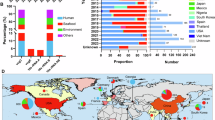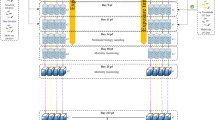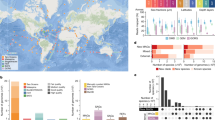Abstract
Disease in oysters has been steadily rising over the past decade, threatening the long-term survival of commercial and natural stocks. Our understanding and management of such diseases are of critical importance as aquaculture is an important aspect of dealing with the approaching worldwide food shortage. Although some bacteria of the Vibrio genus isolated from diseased oysters have been demonstrated to be pathogenic by experimental infection, direct causality has not been established. Little is known about the dynamics of how the bacterial population hosted by oysters changes during disease progression. Combining experimental ecology, a high-throughput infection assay and genome sequencing, we show that the onset of disease in oysters is associated with progressive replacement of diverse benign colonizers by members of a phylogenetically coherent virulent population. Although the virulent population is genetically diverse, all members of that population can cause disease. Comparative genomics across virulent and nonvirulent populations identified candidate virulence factors that were clustered in population-specific genomic regions. Genetic analyses revealed that one gene for a candidate virulent factor, a putative outer membrane protein, is necessary for infection of oysters. Finally, analyses of oyster mortality following experimental infection suggest that disease onset can be facilitated by the presence of nonvirulent strains. This is a new form of polymicrobial disease, in which nonpathogenic strains contribute to increase mortality.
Similar content being viewed by others
Log in or create a free account to read this content
Gain free access to this article, as well as selected content from this journal and more on nature.com
or
References
Bachere E, Gueguen Y, Gonzalez M, de Lorgeril J, Garnier J, Romestand B . (2004). Insights into the anti-microbial defense of marine invertebrates: the penaeid shrimps and the oyster Crassostrea gigas. Immunol Rev 198: 149–168.
Bassler BL . (2002). Small talk. Cell-to-cell communication in bacteria. Cell 109: 421–424.
Cohen AL, Oliver JD, DePaola A, Feil EJ, Boyd EF . (2007). Emergence of a virulent clade of Vibrio vulnificus and correlation with the presence of a 33-kilobase genomic island. Appl Environ Microbiol 73: 5553–5565.
Cordero OX, Wildschutte H, Kirkup B, Proehl S, Ngo L, Hussain F et al. (2012). Ecological populations of bacteria act as socially cohesive units of antibiotic production and resistance. Science 337: 1228–1231.
Criscuolo A, Gribaldo S . (2010). BMGE (Block Mapping and Gathering with Entropy): a new software for selection of phylogenetic informative regions from multiple sequence alignments. BMC Evol Biol 10: 210.
Daubin V, Gouy M, Perriere G . (2002). A phylogenomic approach to bacterial phylogeny: evidence of a core of genes sharing a common history. Genome Res 12: 1080–1090.
Duperthuy M, Binesse J, Le Roux F, Romestand B, Caro A, Got P et al. (2010). The major outer membrane protein OmpU of Vibrio splendidus contributes to host antimicrobial peptide resistance and is required for virulence in the oyster Crassostrea gigas. Environ Microbiol 12: 951–963.
Duperthuy M, Schmitt P, Garzon E, Caro A, Rosa RD, Le Roux F et al. (2011). Use of OmpU porins for attachment and invasion of Crassostrea gigas immune cells by the oyster pathogen Vibrio splendidus. Proc Natl Acad Sci USA 108: 2993–2998.
Edgar RC . (2004). MUSCLE: multiple sequence alignment with high accuracy and high throughput. Nucleic Acids Res 32: 1792–1797.
Faury N, Saulnier D, Thompson FL, Gay M, Swings J, Le Roux F . (2004). Vibrio crassostreae sp. nov., isolated from the haemolymph of oysters (Crassostrea gigas). Int J Syst Evol Microbiol 54: 2137–2140.
Froelich B, Ayrapetyan M, Oliver JD . (2012). Vibrio vulnificus integration into marine aggregates and subsequent uptake by the oyster, Crassostrea virginica. Appl Environ Microbiol 79: 1454–1458.
Gay M, Berthe FC, Le Roux F . (2004a). Screening of Vibrio isolates to develop an experimental infection model in the Pacific oyster Crassostrea gigas. Dis Aquat Organ 59: 49–56.
Gay M, Renault T, Pons AM, Le Roux F . (2004b). Two Vibrio splendidus related strains collaborate to kill Crassostrea gigas: taxonomy and host alterations. Dis Aquat Organ 62: 65–74.
Guindon S, Dufayard JF, Lefort V, Anisimova M, Hordijk W, Gascuel O . (2010). New algorithms and methods to estimate maximum-likelihood phylogenies: assessing the performance of PhyML 3.0. Syst Biol 59: 307–321.
Hunt DE, David LA, Gevers D, Preheim SP, Alm EJ, Polz MF . (2008). Resource partitioning and sympatric differentiation among closely related bacterioplankton. Science 320: 1081–1085.
Ibarra JA, Steele-Mortimer O . (2009). Salmonella—the ultimate insider. Salmonella virulence factors that modulate intracellular survival. Cell Microbiol 11: 1579–1586.
Labreuche Y, Le Roux F, Henry J, Zatylny C, Huvet A, Lambert C et al. (2010). Vibrio aestuarianus zinc metalloprotease causes lethality in the Pacific oyster Crassostrea gigas and impairs the host cellular immune defenses. Fish Shellfish Immunol 29: 753–758.
Le Roux F, Binesse J, Saulnier D, Mazel D . (2007). Construction of a Vibrio splendidus mutant lacking the metalloprotease gene vsm by use of a novel counterselectable suicide vector. Appl Environ Microbiol 73: 777–784.
Le Roux F, Zouine M, Chakroun N, Binesse J, Saulnier D, Bouchier C et al. (2009). Genome sequence of Vibrio splendidus: an abundant planctonic marine species with a large genotypic diversity. Environ Microbiol 11: 1959–1970.
Le Roux F, Davis BM, Waldor MK . (2011). Conserved small RNAs govern replication and incompatibility of a diverse new plasmid family from marine bacteria. Nucleic Acids Res 39: 1004–1013.
Mann AJ, Hahnke RL, Huang S, Werner J, Xing P, Barbeyron T et al. (2013). The genome of the alga-associated marine flavobacterium Formosa agariphila KMM 3901T reveals a broad potential for degradation of algal polysaccharides. Appl Environ Microbiol 79: 6813–6822.
Otto M . (2009). Bacterial sensing of antimicrobial peptides. Contrib Microbiol 16: 136–149.
Petton B, Pernet F, Robert R, Boudry P . (2013). Temperature influence on pathogen transmission and subsequent mortalities in juvenile Pacific oysters Crassostrea gigas. Aquacult Environ Interact 3: 257–273.
Preheim SP, Timberlake S, Polz MF . (2011). Merging taxonomy with ecological population prediction in a case study of Vibrionaceae. Appl Environ Microbiol 77: 7195–7206.
Samain JF . (2008). Summer mortality of Pacific oyster Crassostrea gigas. The Morest Project, Versailles, Editions Quae, 37p.
Saulnier D, De Decker S, Haffner P, Cobret L, Robert M, Garcia C . (2010). A large-scale epidemiological study to identify bacteria pathogenic to Pacific oyster Crassostrea gigas and correlation between virulence and metalloprotease-like activity. Microbial Ecol 59: 787–798.
Sawabe T, Ogura Y, Matsumura Y, Feng G, Amin AR, Mino S et al. (2013). Updating the Vibrio clades defined by multilocus sequence phylogeny: proposal of eight new clades, and the description of Vibrio tritonius sp. nov. Front Microbiol 4: 414.
Szabo G, Preheim SP, Kauffman KM, David LA, Shapiro J, Alm EJ et al. (2012). Reproducibility of Vibrionaceae population structure in coastal bacterioplankton. ISME J 7: 509–519.
Thompson JR, Pacocha S, Pharino C, Klepac-Ceraj V, Hunt DE, Benoit J et al. (2005). Genotypic diversity within a natural coastal bacterioplankton population. Science 307: 1311–1313.
Tomich M, Planet PJ, Figurski DH . (2007). The tad locus: postcards from the widespread colonization island. Nat Rev Microbiol 5: 363–375.
Vallenet D, Belda E, Calteau A, Cruveiller S, Engelen S, Lajus A et al. (2013). MicroScope—an integrated microbial resource for the curation and comparative analysis of genomic and metabolic data. Nucleic Acids Res 41: D636–D647.
Wendling CC, Batista FM, Wegner KM . (2014). Persistence, seasonal dynamics and pathogenic potential of Vibrio communities from pacific oyster hemolymph. PLoS One 9: e94256.
Yu X, Doroghazi JR, Janga SC, Zhang JK, Circello B, Griffin BM et al. (2013). Diversity and abundance of phosphonate biosynthetic genes in nature. Proc Natl Acad Sci USA 110: 20759–20764.
Zerbino DR, Birney E . (2008). Velvet: algorithms for de novo short read assembly using de Bruijn graphs. Genome Res 18: 821–829.
Acknowledgements
We warmly thank Brigid Davis (HMS, Boston, USA), Marylise Duperthuy (Umea University, Sweden), Otto X Cordero (ETH Zurich, CH) and Martin F Polz (MIT, Cambridge, USA) for fruitful discussions and critically reading the manuscript. We thank the staff of the station Ifremer Argenton and Bouin, the ABIMS and CRBM (Roscoff) and LABGeM (Evry) platforms for technical support. FLR acknowledges the VIBRIOGEN consortium (Annick Jacq, Delphine Destoumieux and Guillaume Charrière) for our precious exchanges. This study has been supported by the Region Bretagne (SAD Vibrigen 6633; to TV), the ANR blanc (11-BSV7-023-01 ‘VIBRIOGEN’; to DG), the EMBRC France (to AL) and Ifremer (to DG and TV).
Author information
Authors and Affiliations
Corresponding author
Ethics declarations
Competing interests
The authors declare no conflict of interest.
Additional information
Author Contributions
AL, TV, BP, YL and FLR performed experiments; DG and AC performed the in silico analyses; YL and FLR designed experiments, interpreted results and wrote the paper; AL, DG and TV contribute equally to this work. The manuscript has been seen and approved by all authors. The material represents an original result and has not been submitted for publication elsewhere.
Supplementary Information accompanies this paper on The ISME Journal website
Supplementary information
Rights and permissions
About this article
Cite this article
Lemire, A., Goudenège, D., Versigny, T. et al. Populations, not clones, are the unit of vibrio pathogenesis in naturally infected oysters. ISME J 9, 1523–1531 (2015). https://doi.org/10.1038/ismej.2014.233
Received:
Revised:
Accepted:
Published:
Issue date:
DOI: https://doi.org/10.1038/ismej.2014.233
This article is cited by
-
A core of functional complementary bacteria infects oysters in Pacific Oyster Mortality Syndrome
Animal Microbiome (2023)
-
A MALDI-TOF MS database for fast identification of Vibrio spp. potentially pathogenic to marine mollusks
Applied Microbiology and Biotechnology (2021)
-
Oyster hemolymph is a complex and dynamic ecosystem hosting bacteria, protists and viruses
Animal Microbiome (2020)
-
Achieving a multi-strain symbiosis: strain behavior and infection dynamics
The ISME Journal (2019)
-
Characterisation of the Pacific Oyster Microbiome During a Summer Mortality Event
Microbial Ecology (2019)



